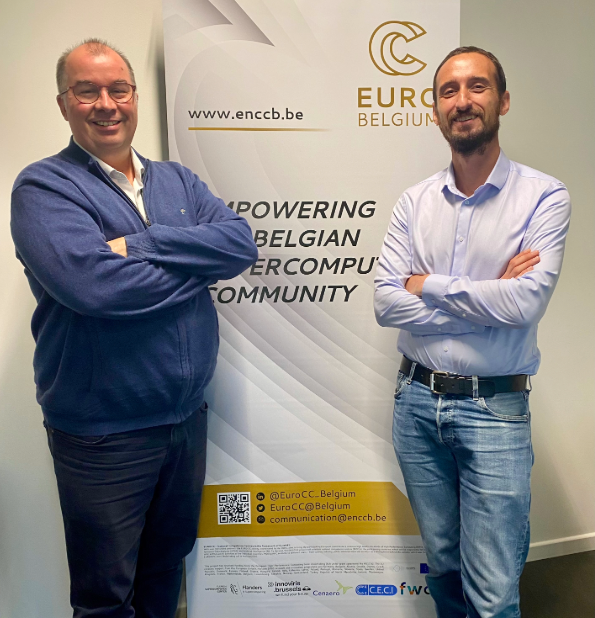Interview with Anthony Bievelez (Skywin Cluster)

EuroCC Belgium met Anthony Bievelez, Project Manager at Skywin, the Walloon aerospace cluster, at Cenaero’s offices in Gosselies.
Skywin is the Walloon aerospace cluster, where technological innovation plays a key strategic role to keep Walloon industrial players, from SMEs to large companies, at the highest technological level.
Is HPC a strategic resource for Walloon industrial players (SMEs & large companies)?
The answer is yes! Today, having significant computing power is indispensable because R&D activities heavily rely on digital technology. For example, in mechanical modeling, we can simulate the interactions between mechanics, assembly, and various physical phenomena (temperature, electromagnetism, etc.). This "multiphysics" approach adds real value. HPC enables us to consider more complex interactions and assemblies than before, acting as a major lever for innovation in the aeronautics sector.

Using HPC also results in time-savings and increased profit margins. Facing a shortage of engineering talents, it's important to optimize their work. HPC is likely a strategic factor for optimizing "time to market" and the return of investment of engineering activities.
HPC and AI help develop new products and functionalities. In production, for instance, HPC addresses specific modeling needs of the production chain (optimization of flows, factory logistics management). Thanks to such technology, we can now develop a dynamic digital twin of a factory!
So yes, I believe HPC is indeed a strategic resource. In the aerospace sector, which is resource-intensive, specialists have equipped themselves according to their needs. In the industry, players favor a "make or buy" approach: either they outsource specific operations/calculations to a specialist or handle them internally.
What role does high-performance computing play in the competitiveness of Walloon Aerospace and Defense players? Can you provide examples?
Many Skywin members use advanced numerical simulation. Competitiveness is demonstrated through new functionalities, cost efficiency, or speed in bringing innovative products to market. These three factors are linked to computing power.
Some Skywin members have their own equipment, while others use external computing infrastructures. Some even complement in-house computing power with external resources, adopting the "HPC as a Service" model.
The Walloon Region also heavily invests in aerospace innovation, notably through the WINGS project (Walloon Innovations for Green Skies), currently in its third phase. HPC plays a significant role in this project, with Cenaero contributing to diverse areas—from aircraft’s structure components and systems associated to propulsion, materials, manufacturing processes, and Industry 4.0, combining simulation, AI, and HPC.
Here are some recent concrete examples: the latest WINGS technical day at the end of 2024 enabled the sharing of the optimized redesign of a roller box, a key element in the wing control surface kinematics, considering the new possibilities given by the additive manufacturing technology; the weight reduction of air taxi wings using composite materials; the coupled aero-mechanical optimization under ice ingestion constraints of a low-pressure compressor rotor; the aero-acoustic improvement of movable wing elements. The computations that lead to these innovations were all carried out on Lucia, the supercomputer operated by Cenaero for the benefit of both the research and regional industrial sectors.
From material development to process control and product design, HPC enables the deployment of numerical modeling to better understand, explore, and then master the physics and new design spaces, integrating accuracy and the multiple required disciplines. Currently, the aerodynamic calculation of a complete low-pressure compressor with distortion is underway, representing millions of computing hours, aiming to understand the detailed flow and the propagation of distortion through the compressor, whose increased exposure to distortion in new engine architectures makes this kind of simulations even more critical.
You can also study phenomena further to our planet surface. In the context of the proliferation of space debris in Earth's orbit, calculations aiming to characterize the aerodynamic behavior and degradation of space debris during critical phases of their atmospheric reentry can be cited. The idea is, for example, to simulate and understand, in relation to experimental tests and measurements, the impact of the plasma phase of atmospheric reentry on the behavior of space debris. Sufficiently accurate models are essential, whether in a design-for-demise approach or in a controlled reentry process.

Aeronautics is a cutting-edge sector with complex and lengthy development cycles. In light of environmental challenges and ambitious decarbonization plans—ultra-frugality followed by net zero by 2050—we are witnessing an unprecedented acceleration in development and innovation cycles. What is the role of HPC?
The industry must adapt—no doubt about it! Computing power is a key lever for innovation. Achieving net zero requires reducing consumption through structural lightweighting, aircraft electrification, and propulsion optimization—all areas accelerated by HPC.
Lightweighting will involve developing new materials, where HPC proves invaluable. Matgenix's testimonial supports this. Electrification will also drive structural weight reduction. Contrary to common belief, aircraft electrification isn't limited to electric propulsion—it's about replacing mechanical actuator chains with electric or electromechanical actuators, achieving significant weight savings. This technological shift must be handled cautiously due to safety concerns, and again, HPC will speed up this transition.
Overall, HPC contributes to a more competitive industry, enabling virtual development and testing of new materials, reducing development costs, and saving time.
What are the current barriers to HPC adoption among Aerospace-Defense players in Wallonia?
A major concern is secure data management—a sensitive issue for industrial players. Solutions exist but require case-by-case adaptation. Beyond industrial requirements, regulations, especially European ones, play a role.
The Belgian NIS2 law, entered into force at the end of 2024, raises cybersecurity standards, notably in sectors like air transport, space, digital technologies, and research—core activities in the Skywin ecosystem. The impact of these new requirements throughout the critical sectors' supply chains could surpass that of GDPR.
Are Walloon Aerospace players sufficiently aware of HPC? Would additional outreach be beneficial?
Those turning to HPC understand the limitations of traditional computing and are aware of global computing power availability. However, they may not realize the existence of supercomputers at a more local level (Belgium and Walloon Region) and their accessibility for academia and industry.
Beyond existing visibility efforts, clarifying the commercial offerings and simplifying technical access would likely help business decision-makers embrace HPC as a tool for differentiation and accelerated development.

From left to right: Anthony Bievelez, Project Manager at Skywin, Benoît Dompierre, Head of Belgian National Competence Center on HPC/HPDA/AI, EuroCC Belgium
Published 16/05/2024